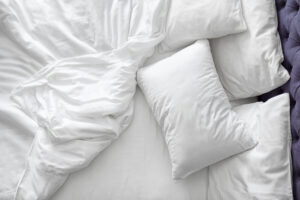Full vs. Queen Sheets: Which to Use?
Disclosure: By clicking on the product links in this article, Mattress Nerd may receive a commission fee at no cost to you, the reader. Read full disclosure statement.
Sizing for sheets isn’t always standard, which can be confusing when you set out to purchase a new bed sheet set. One company might produce sheets in dimensions that match standard bed sizes exactly, while another brand’s Full sheets have the measurements of a Double bed. If you’re trying to figure out what to buy for your mattress size, we explain below. For more information on choosing your sheets, check out our Best Sheets Guide.
Size Specifications for Queen vs. Full Sheets
Full-size sheets typically measure 54” x 75”, and Queen-size bed sheet sets typically measure 60” x 80”. There are variations on these dimensions, such as California Queen–size bed sheet sets, but most Full- and Queen-size sheet sizes will be in this range, give or take several inches.
Fitted Sheets vs. Flat Sheets
The need for a flat sheet is up for debate in different corners of the world, so it’s important to understand the purpose of flat sheets and fitted sheets so you can make a decision for yourself.
A fitted sheet is simply meant to cover your mattress. It creates a soft, smooth sleeping surface and typically has elastic at the corners that wrap around the bed to ensure a snug fit. Each corner of the sheet tucks around and under the corner of the bed, an arrangement that helps fix the sheets securely on the bed even when a sleeper tosses and turns throughout the night.
A flat sheet, or top sheet, is typically placed on top of the fitted sheet and rests in between the sleeper and their blanket or duvet. Its purpose is to keep you warm and to protect your bedding from getting dirty. Some people dislike flat sheets because they add a bit of extra time when making the bed, but here at Mattress Nerd we think flat sheets are a valuable extra touch to make a bed feel luxurious and more hotel-like.
So, which is right for you? Skipping a flat sheet may save you a few seconds on your bed-making time, which is a valid concern for people who want to simplify their lives and start their days faster. Still, you may have to launder your bedding more frequently if you skip the flat sheet, since you lose out on a protective layer between yourself and your duvet cover.
You’ll have to do the math on your personal lifestyle to see if renouncing a flat sheet will actually save you time in the long run. If you shower right before getting into bed at night, you shouldn’t worry too much about sleeping right up against your duvet or comforter. If you tend to crash right into bed after a long, sweaty day, or if you tend to sleep hot and are prone to body acne caused by sweat buildup and dirty bedding, you might find it worthwhile to use a flat sheet.
Using Full-Size Bed Sheets on a Queen-Size Bed
If you recently purchased a Queen mattress but only have Full-size sheets on hand, you might be asking the question: “Will my Full sheets fit a Queen-size bed?” Full and Queen sheets aren’t always interchangeable because sizing varies widely, so there’s no straightforward answer. Even just a couple of inches difference in width and length can make it practically impossible to put a fitted sheet on a larger mattress.
However, some Full bed sheets will fit a Queen bed. You shouldn’t experience any problems with the flat sheet, especially if it has deep pockets designed to wrap around tall beds. You’re more likely, on the other hand, to run into problems with the fitted sheet. First, try getting a friend to help you: Each of you should grab two corners of the fitted sheet and try stretching the sheet over the mattress and affixing it to all four corners.
Pure cotton sheets and linen sheets are a bit less stretchy than jersey sheets (picture the stretchy T-shirt material used in some lower-end bedding), so you may have better luck stretching the latter over a too-big bed. If the fitted sheet is ultimately too small, consider using two Full flat sheets instead: one tucked on all four sides as the fitted sheet, and one left loose on top as the flat sheet.
Sheet Straps
If the Full-size bed sheets won’t stay in place on their own on your Queen-size mattress, consider purchasing sheet straps to keep them in place. Also known as sheet suspenders, sheet straps help keep your fitted sheets in place by clipping to the edges of the fabric.
Which Mattress Size Works Better: Full or Queen?
A Full mattress measures 54” x 75”, making it just a bit smaller than a standard Queen-size mattress, which measures 60” x 80”. Both mattress sizes are typically recommended for one person with a pet or two adults with no pets, so mattress shoppers should take other factors into account when selecting the right size for their new bed.
- Price—Queen-size mattresses are typically $100 to $400 more expensive than Full-size models, and Queen-size bedding accessories (comforters, duvets, toppers, mattress pads, Queen-size sheets, bed frames, etc.) will tend to be more expensive as well.
- Space—A Full-size bed provides extra space for single sleepers who like additional sleeping space, and a Queen-size provides even more surface area. Couples with large master bedrooms who like to spread out should consider a King-size bed or California King–size mattress.
- Height—A Full-size mattress may be too short for anyone who is 6’3” or taller.
- Availability—A Queen-size mattress is an industry standard, so practically every mattress manufacturer carries each of their mattress models in this size. Full-size mattresses—bedding accessories like sheets and mattress protectors—may be slightly more difficult to find, but they’re still very common across the industry.
- Mattress Weight—Queen-size mattresses can weigh more than 100 pounds, making them difficult to move for people who don’t have assistance.
For more information about mattress sizes, visit our Mattress Dimensions Guide.


